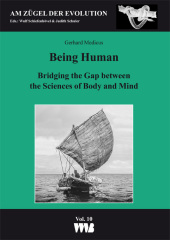 Neuerscheinungen 2017Stand: 2020-02-01 |
Schnellsuche
ISBN/Stichwort/Autor
|
Herderstraße 10
10625 Berlin
Tel.: 030 315 714 16
Fax 030 315 714 14
info@buchspektrum.de |

Norbert Hohl, Sonia Kleindorfer, Gerhard Medicus
(Beteiligte)
Being Human
Bridging the Gap between the Sciences of Body and Mind
Übersetzung: Hohl, Norbert; Kleindorfer, Sonia
2. Aufl. 2017. 216 S. 24 cm
Verlag/Jahr: VWB 2017
ISBN: 3-86135-587-6 (3861355876)
Neue ISBN: 978-3-86135-587-8 (9783861355878)
Preis und Lieferzeit: Bitte klicken
What makes humans human? How are body and mind connected, and how are the sciences of the body connected with the sciences of the mind?
Evolution has left its traces on both the body and the soul. For this reason, accumulated evolutionary knowledge is a useful and indispensable underpinning for a better understanding of humans: social behaviour, moral consciousness, aggression and the inhibition of aggression, attachment behaviour, learning and intellect, political judgment and activity, as well as behavioural differences due to gender. The interlacing of nature, culture and mind is visible in all realms of humanness/human nature/humanity.
This knowledge can help to expand our behavioural freedom, and with that, our freedom to act responsibly.
List of Contents:
Wulf Schiefenhövel: Foreword for the English Edition Preface
Acknowledgements
PART I: Contributions to the epistemology of interdisciplinarity in the human sciences
1. Interdisciplinary theoretical foundation of the natural sciences
1.1 The central questions
1.1.1 The question of causation
1.1.2 The question of ontogeny
1.1.3 The question of adaptive value
1.1.4 The question of phylogeny
1.2 The reference levels
1.3 Chapter appendix: evolutionary psychology, evolutionary medicine
2. Contributions of the humanities to the interdisciplinary dialogue in human sciences
2.1 The body-mind problem: how it came to the separation of academic faculties
2.2 Approaches bridging the division between the humanities and the natural sciences
2.2.1 Popper´s postulate of falsifiability
2.2.2 The structure of the real world according to Nicolai Hartmann
2.2.3 Levels of evidence and demands for certainty
2.2.4 David Hume and Norbert Bischof
2.3 A plea in favour of orientational knowledge
2.4 Chapter appendix: forms of knowledge, Semmelweis Effect
PART II: Behavioural phylogeny in relation to the higher-level systematics of vertebrates
3. On the phylogeny of human cognition
3.1 Evolutionary stages of human cognition
3.1.1 Phylogenetic and ontogenetic knowledge gain
3.1.2 The evolution of cognitive capacities
3.1.3 Communal coexistence and culture; cultural-theoretical considerations
3.1.4 Overlaps between concepts of psychotherapy and ethology
3.2 Chapter appendix: further aspects of hominisation
4. From animal brood care to human social behaviour
4.1 From brood care to cooperativeness and its limits
4.2 Grieving, greeting and leave-taking
4.3 From brood care to sexual behaviour
4.3.1 Incest avoidance mechanisms
4.3.2 Gender differences
5. The apple from the tree of knowledge and the expulsion from paradise: on the evolution of morality
5.1 Questions about human nature
5.2 Evolutionary origins of humanity
5.2.1 Social attractiveness
5.2.2 Self-exploration and empathy
5.2.3 Time horizon and emphronesis as prerequisites for the ability to feel shame
5.2.4 Reflection and moral responsibility in adult humans
5.2.5 Summary: scope and limitations of cultural freedom
5.2.6 Concluding remarks
6. On the ethology of resource appropriation and ownership
6.1 The resource is appropriated by the strongest
6.2 The resource is appropriated by the higher-ranking individual and/or the first to arrive
6.3 Give and take
6.4 The right to possession is respected even in the absence of the owner
6.5 Chapter appendix: rank order and hierarchy
7. The natural difference: on the biopsychology of gender differences
7.1 General remarks and biological foundations
7.1.1 Benefits of sexual reproduction
7.1.2 Basic principles and causes for the origin of sexual dimorphism
7.2 Sexual reproduction in nonhuman and human primates
7.2.1 Excursus: communication in primates
7.2.2 The sociology of primate mating systems
7.2.3 The "principle of antithesis" in male-female differences
7.2.4 Human sexual behaviour
7.3 Variants of sexual behaviour
7.4 Prospects
8. Does the psychomotor development of children follow the biogenetic rule?
8.1 On the history of the biogenetic rule
8.2 Developmental physiological basis for recapitulation: metaphenes and interphenes
8.3 The significance of the biogenetic rule for biological research
8.4 The biogenetic rule and the ontogenetic development of behaviour
8.4.1 Interphenes commonly lack external adaptive value
8.4.2 Anatomical recapitulation with simultaneous functional "recapitulation"
8.4.3 The role of primordial behaviour in ontogeny
8.4.4 Morphogenesis and psychogenesis as distinct ontogenetic steps
8.4.5 No behavioural interphenes in nervous system ontogeny
8.5 Summary
PART III: Contributions to the ethology of specific behavioural areas and capacities, with an emphasis on universal traits in higher mammals and unique traits in apes and humans
9. O


